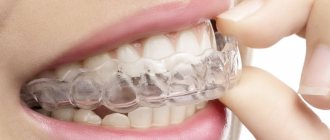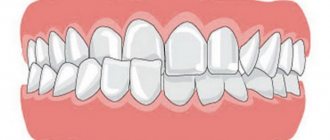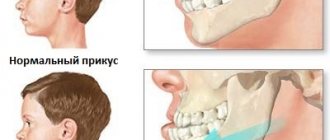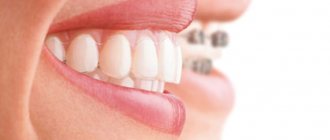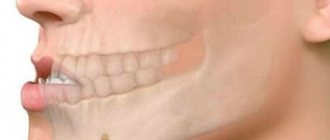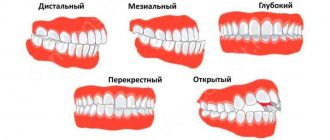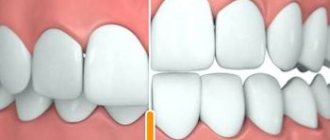- Signs of correct bite
- Types of malocclusion
- Why do you need to correct your bite?
- Until what age can a bite be corrected?
- Ways to correct a bite
- Aligners
- Trainers
- Veneers
- Bracket system
- Types of braces
- Which braces system should you choose?
- How long does it take to correct a bite?
- How to care for braces?
Malocclusion occurs in almost 80% of the Russian population. In a third of cases it requires orthodontic treatment. And it’s not just a matter of aesthetics - if you are often bothered by headaches, earaches and dizziness, then perhaps it’s a malocclusion. An orthodontist deals with the correction and prevention of malocclusions.
The most common misconception about bite is related to age. Many people think that it can only be corrected in childhood, but today, with the advent of new technologies, this can be done at any age.
In this article we will look at the causes and types of malocclusion and why it needs to be corrected. We will also tell you about treatment methods and dispel the most common fears. Orthodontist Olesya Milagina comments on current issues of orthodontic treatment for us.
Signs of correct bite
To begin with, we will show what a normal bite looks like and list the signs by which you can understand that it is normal.
- The main distinguishing feature of a correct bite is the tight contact of the upper and lower jaws when they close. The upper front teeth cover the crowns of the lower ones by a third, that is, the lower incisors come into contact with the palatine tubercles of the upper ones. There is no distance between the upper and lower chewing teeth, and during chewing they are in constant contact.
- Correct bite affects the harmony of facial proportions: the lower and upper jaws are symmetrical.
- There are no speech defects.
- Food is comfortable to bite and chew.
- There is no discomfort or clicking in the jaw joint.
Types of malocclusion
How can you tell if your bite is wrong? Essentially, these are all deviations from the norm that nature has established.
Malocclusion occurs:
- distal - the upper jaw is pushed forward more than the lower jaw;
- mesial - the lower jaw is pushed forward more than the upper jaw;
- deep - the upper teeth overlap the lower ones by more than half their length;
- open - most of the teeth of the upper and lower jaws do not meet;
- cross - the left and right sides of the upper dentition protrude forward unevenly, and the upper and lower teeth meet with cutting edges.
Symptoms
Malocclusions are characterized by different symptoms, but there are also similar signs:
- Deviations from the physiological norm of the position of the jaws and the closure of the dentition.
- Asymmetry of facial features.
Malocclusion is not only an aesthetic problem. Due to the fact that the teeth do not close properly, normal chewing of food is difficult. As a result, adult patients with dental anomalies often face various problems:
- Pain in the jaws and chewing muscles.
- Clicking in the joint while chewing, talking, yawning.
- High abrasion of teeth and their rapid destruction.
- Problems with the gastrointestinal tract.
Correction of malocclusion in adults is carried out by orthodontists, gnathologists, and maxillofacial surgeons. This is due to the fact that in an adult, the arrangement of the dentition, the shape and position of the jaws have already been formed, and the bone tissue is completely mineralized. As a result, orthodontic methods alone cannot always bring the desired result and completely straighten the bite.
Often, after basic malocclusion treatment, adult patients require the help of an orthopedist. This is due to the fact that after aligning the dentition, occlusal correction is required. For this purpose, crowns or special ceramic onlays are used.
Why do you need to correct your bite?
- Increased abrasion, caries and tooth loss.
Normally, when chewing, the load is evenly distributed across all teeth. When there is a malocclusion, the load on some teeth increases, while on others there is practically no load. On teeth that “work for two,” the enamel wears off faster, chips appear, and the teeth themselves become loose. Teeth that are “resting” are more vulnerable to caries. - Gum diseases.
With an incorrect bite, the teeth can be tilted inward or, conversely, turned toward the lips. Eating or even normal conversation can injure the inside of the cheeks and tongue. The gums also suffer: the volume of tissue gradually decreases, exposing the roots of the teeth. - Diseases of the temporomandibular joint.
Incorrect positioning of the incisors over time leads to displacement of the jaw joints relative to each other. The pathology is accompanied by muscle spasms, bruxism, crunching and clicking while eating or talking. - Diseases of the food tract.
The bite is responsible for chewing and swallowing, and defects in the bite disrupt this process. Poorly chopped products are an additional burden on the gastrointestinal tract, which provokes gastritis, enterocolitis and problems with stool. - Breathing problems and ENT diseases.
The accumulation of bacteria in the mouth during an open bite can cause sinusitis, sinusitis, otitis media, and sore throat. - Communication problems and complexes.
For 60% of patients, braces are aesthetics; for the remaining 40%, it is either the functionality of the masticatory apparatus, or a solution to a problem with the temporomandibular joint, or a preparatory stage before prosthetics.
How much does it cost to straighten teeth without braces with orthodontist A. A. Arzumanov?
At an appointment with orthodontist Andranik Arkadyevich Arzumanov, the patient receives advice on possible correction of malocclusion without braces. After a complete diagnosis, at the patient’s request, teeth are straightened with aligners. The prices for the devices used are presented in the table.
Orthodontic treatment without braces - with aligners
| Name of service | Price, rub. |
| Orthodontic treatment using an aligner (up to 5 drops) | 50 000 |
| Orthodontic treatment using an aligner (up to 10 drops) | 80 000 |
| Orthodontic treatment using an aligner (up to 20 drops) | 130 000 |
By using alternative methods of teeth straightening, minor bite pathologies can be corrected or masked; however, only braces can effectively cope with severe anomalies.
Ways to correct a bite
Today there are four ways to correct a bite and one way to carefully disguise the problem.
- Aligners
- Trainers
- Bracket systems
- Surgical intervention
We have listed these methods in order from easiest to most difficult. You must understand that each case is individual, and depending on this, the doctor will select the optimal bite correction system. You can hide an unaesthetic bite with the help of veneers - we will also talk about them.
Aligners
Removable aligners that are created from dental impressions. The most modern way to correct a bite, which is suitable for the treatment of simple disorders.
After drawing up a treatment plan, the patient receives 3–5 sets of aligners of varying stiffness. The mouth guard is designed to last for two weeks, and then it needs to be changed to the next one, and so on until the final result. The course of treatment lasts on average 4–8 weeks.
Aligners need to be worn 24 hours a day, and this may not be comfortable for everyone. They are not suitable for deep bites. The mouthguard is designed so that it is “one step” ahead of the current position of the teeth in the dentition. Therefore, after putting it on, pressure is felt, which is evenly distributed throughout the jaw. Aligners consist of an elastic transparent material, so they are invisible to others, unlike braces.
Trainers
Removable silicone mouth guards for two jaws, which help correct a simple bite or consolidate the result. You need to wear the trainer during sleep and during the day for up to 4 hours.
Veneers
The characteristics are similar to crowns, but they are installed only on the front surface of the tooth in the form of a thin plate on a special dental glue.
Veneers can be composite, ceramic or zirconium. The first two types last about 10 years. Products made of zirconium dioxide with external porcelain coating - up to 15 years.
Veneers eliminate defects that arise as a result of cracks or damage to the integrity of teeth. A visually straight dentition is formed.
For the patient, the result of orthodontic treatment is aesthetics, and for the doctor, it is functionality. If your teeth are just crooked and your bite is perfect, you can get veneers or crowns. In other cases, you cannot do without braces: veneers do not correct the position of the teeth, but only mask their external imperfections.
Bracket system
Braces are small clasps that are attached to the teeth with a special composite glue. A metal arch is placed in the grooves of the braces - the most important element of the braces system. The arch has the shape of a regular dentition. She pulls her teeth, setting them in the correct position. In order for the bracket system to successfully complete its work, it is important to periodically change the arches to more elastic ones.
The doctor fixes the arch on the braces with special rubber bands - ligatures. Depending on the task at hand and the required force that will act on each tooth and jaw as a whole, the orthodontist can choose metal or elastic ligatures. The latter have a clear advantage - when they are changed, you can get rid of the bacteria accumulated under them.
Increased salivation in the first days after installation is a good reaction of the body. The tongue contains sensory neurons that, when food appears in the mouth, send signals to the brain to turn it into a food bolus. When braces are put on your teeth, at first the brain perceives them as food. This is the body’s reflex that there is something in the mouth, which means it needs to be treated with saliva in order to then swallow it. After some time, the salivary glands will get used to it.
Does it hurt to wear braces?
The first days are unusual, but not painful. But if braces scratch your lips and cheeks, you shouldn’t tolerate it. “ Make an appointment with your orthodontist. Sharp elements can be corrected with special materials and filled with special wax
“, our expert advises.
The same applies to tooth sensitivity: sign up for a diagnosis. It is possible that areas of demineralization have appeared. Depending on what the teeth react to, further treatment will depend.
Types of braces
Braces are classified according to the following criteria:
- material (metal, plastic, ceramic and sapphire);
- technique (classical and self-ligating, without ligatures);
- Place of installation (on the outer surface of the teeth - vestibular, on the inner surface - lingual).
Metal braces
Despite the fact that these are the oldest braces systems, they are still popular, and not only because they are the cheapest. Their main advantage is the minimal friction force between the groove and the arc, the magnitude of which largely determines the duration of the entire treatment.
The only negative is that such braces are noticeable on the teeth. However, modern designs differ from their ancestors - they are smaller and more convenient.
Plastic braces
Second after metal ones in the price range. Since plastic itself is not strong enough, the design has metal grooves. Their disadvantage is that such braces are stained by coffee, tea and other coloring products. They are also more fragile than others. However, plastic braces come in a variety of colors and shapes and are therefore popular in pediatric orthodontics.
Ceramic braces
More expensive, but stronger than plastic ones. The color matches the color of the teeth, which makes them almost invisible. Their disadvantage is higher friction between the arch and the bracket slot, which can increase the duration of treatment.
Sapphire braces
Artificial sapphires are used to make them. They are transparent and shimmer beautifully in certain lighting. This design will appeal to those who are sensitive to aesthetics.
Combined braces
Consist of several materials. In the smile area it can be ceramics or sapphires, and in the chewing area it can be metal.
Lingual braces
They are attached to the inside of the teeth and are invisible to others. Their main disadvantage is their high cost. Also, at first they may interfere with diction, but after 2-3 weeks the language adapts and the problem goes away.
Aligners (orthodontic aligners)
Aligners or aligners are removable orthodontic structures that are used in the treatment of adults with minor bite problems. They are made from polycarbonate using dental impressions. You need to wear the mouthguard almost constantly and only take it off when eating. The aligner applies pressure, as a result of which the bone tissue of the alveoli on the side where the tooth moves begins to dissolve. The tooth moves, and new bone tissue is formed on the side opposite to the movement. Aligners are made individually. When correcting the bite, they are changed so that the same pressure is applied to the teeth that have changed their position.
Which braces system should you choose?
The least expensive and most proven option is metal braces. Plastic ones are also inexpensive, but they are inferior in strength to metal ones. If aesthetics are more important to you, opt for more expensive ceramic, sapphire or lingual braces.
As for “internal” braces, their only difference from all others is the aesthetic factor. One of the inconveniences is that such braces change the diction, they are more difficult to care for and they are not suitable for everyone. You need to have an almost perfect bite: just “uneven teeth.”
How long does it take to correct a bite?
Each case is individual, so without visiting a doctor it is impossible to say how long treatment will take.
The minimum treatment takes a year for the bone to grow and the teeth not to come back. The result needs to be stabilized. Patients often tell me after two months of wearing braces: “I want to take them off, everything is already straight for me!” But this is appearance. The jaw bones must anchor the teeth into their new position.
The duration of treatment also depends on the patient. The orthodontist puts a certain force into the braces, which weakens by the next visit. That is why it is important to strictly visit the doctor once a month so that you do not have to prolong the course of treatment.
My teeth began to loosen. Something is going wrong?
Loose teeth after installation should not scare you. The teeth will be in motion throughout the treatment period. Essentially, we move our teeth: somewhere the bone dissolves, somewhere it appears. Six months after treatment, the teeth will return to normal.
The purpose of braces is to change the position of hard and soft tissues adjacent to the tooth. But this is not enough to correct the bite. Teeth may move back apart some time after braces are removed if a retention device is not in place. After correction, retainers must be installed to keep the teeth stable in their new position. If this is not done, the effect of wearing braces will gradually disappear.
Complex.
It implies a set of corrective techniques to achieve a better result.
Myotherapy and surgery are used infrequently. In the first case, the method is limited by the patient’s age and is used for children 3-5 years old, when the emphasis is on the proper development of masticatory and facial muscles. Surgical techniques are indicated for extremely serious pathologies - when other methods have not helped, and the lack of correction is fraught with serious health consequences.
Most often, orthodontists use an integrated approach - a combination or alternation of hardware techniques.
How to care for braces?
Caring for braces requires care and discipline. We talked about it in more detail in a separate article. After installing braces, the doctor will tell you how to live now. We will indicate the most important things.
- Always have brushes and a single-tuft brush on hand.
- Add a waterpik to your arsenal.
- If you are not sure that you have brushed your teeth well, use an indicator tablet. After brushing your teeth, the tablet must be dissolved in your mouth. The areas where plaque remains will turn blue. These areas need to be cleaned again.
- Avoid very hot and very cold drinks. Braces, like enamel, do not like sudden temperature changes.
- To prevent braces from coming off, follow a diet. Eliminate nuts, toffees, seeds, and flour from your diet. Apples and other hard fruits should not be bitten off, but cut into small pieces and placed on the chewing teeth.
